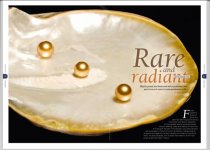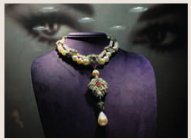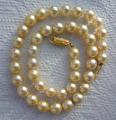Cyril Roger Brossard
Well-known member
- Joined
- Aug 30, 2012
- Messages
- 408
Allow me to share this article displayed in the on-board magazine SilkWinds of May-June 2012 (not sure if this was covered...)

Rare and Radiant
Highly prized and bedecked with symbolism, the pearl is one of nature’s most spectacular gifts
By Jerico Abila
Fondly called the queen of Gems, the pearl has had a long and illustrious history both as a fashion accessory of incomparable beauty and as a priceless treasure befitting royalty and nobility, For centuries, this rare gem has been immortalized in countries literature and showcased in many forms of art and fashion. Highly prized for its beauty and elegance, the pearl has been the subject of interest for many, including Cleopatra, who is said to have two of the most exquisite pearl earrings in history.
Page 2

Caption: Above: oysters thrive in a pristine environment with clean moving water, and constant tidal patterns and temperatures.
Fascination for the pearl reached its peak during the Roman Empire. Lolia Paulina, the third wife of Emperor Caligula, was known for her life-long passion for pearls and emeralds, while the Roman General Vitellius is believed to have funded his entire military campaign by trading a piece of his mother’s pearl earrings. Also during the Roman Empire, women were so enamoured with the rare gem that they upholstered couches with pearls and adorned their gowns with countless radiant pieces.
In Asia, the storied gem appears in various historical texts, the earliest of which is believed to be about 4000 years ago in China, where they produce “strings of pearls that were not quite round”. The pearl also appears in ancient India, particularly the 3000 year old Rigveda, the oldest of the Vedas.
Various myths and legends surround the origin of the pearl. Some believe it is a source of great power while others regard it as medicinal, capable of treating a range of ailments. And for a very few, pearls are believed to be “tears of God”.
In Hindu culture, the pearl is associated with the moon and is symbolic of love and purity. It is believed tat Lord Krishna discovered the first pearl and presented it to his daughter Pandaia on her wedding day. In Islamic beliefs, the pearl is regarded in the Quran as one of the greatest rewards found in Paradise. In Christianity, the pearl represents purity and protection from evil.
The colour of a pearl is also bedecked with symbolism: black and gold for wealth, blue for love and pink for success.
Whatever the myth, origin or purpose, it remains a mystery when and where our global fascination for this gem first sprung up. But one thing’s for sure: whoever first discovered the pearl must have been mesmerized by it’s soft glow and unique lustre.
The pearl is one of the most universal and oldest jewels known to man. It has been around long before gold and diamonds were mined for jewelry. Unlike most gemstones that are buried in the earth, the pearl originated from a living creature, an oyster, or in some cases, from varieties of clams and mussels. Another characteristic that sets it apart from the other gems is its natural glow. The natural iridescent pearl requires no cutting, no polishing to reveal its beauty and radiance.

Caption: the 2400-year-old Susa Necklace is the oldest pearl necklace still in existence. It was discovered in the tomb of a Persian princess who was buried with it.
One of the most celebrated pearls in modern history is the Pearl of Lao Tzu, also known as a Tridacna pearl, from a giant clam. It was discovered by an American scientist in the Philippine waters. At 24 centimetres in diameter and 6.4 kilograms in weight, this is the world’s largest known pearl.
Another pearl of distinct beauty is the La Peregrina, which once belonged to the legendary Hollywood actress Elizabeth Taylor. In December last year, the rare piece was auctioned off at Christie’s for a record-breaking US$11.84 million.
Page3

Caption: The Kantha, a traditional Indian pearl necklace is an important accessory for Indian grooms.
Rounded, irregularly shaped or golden, the pearl is one of nature’s most spectacular gifts. Its creation begins with a single oyster that requires a foreign substance or irritant to catalyse the process. Protecting itself from the foreign substance, the oyster secretes layers of nacre to cover the irritant, which in the process creates the pearl.
Pearls can be classified as freshwater or saltwater. The former grow in certain lakes, ponds and rivers, and come from a specific family of mussels. They are more varied in colour and mostly irregular shaped, with sized ranging from 4 to 10 millimetres.
Saltwater pearls grow from the world’s seas. The process is long and random: one in a thousand oyster shells may contain a pearl, and perhaps only one of those may be considered truly exquisite.
Traditional pearling techniques involve free-divers manually collecting large numbers of oysters from the ocean floors and searching them for pearls. This technique is slowly becoming obsolete due to insignificant yields –typically, a ton of pearl oysters produces only three to four quality pearls. Growing global demand is pushing pearling techniques to be more cost-effective.
Pearls occur naturally in nature, most of which are formed randomly. Natural pearls rarely have commercial value, which creates a bigger market for cultured pearls, or pearls formed with human intervention. Cultured pearls are prized for their outstanding beauty and what they represent –years of dedication and hard work from the nurturing hands of pearl farmers. Ore importantly, cultured pearls pay tribute to the efforts of Kokichi Mikimoto, who launched the cultured pearl industry when he patented technique in 1916.
There are close to a dozen varieties of pearls, with some of the world’s most exquisite found in Asia and Australia’s pristine waters. The Akoya pearl, for instance, is grown mainly in Japan and China. Considered the most lustrous pearl type, they are cultured in the Pinctada fucata martensii, or the Akoya oyster. They are roundish and feature a spectrum of colours, from light pink to
Page4

Caption: South Sea pearl black pearl and freshwater pearls on display.
white or creamy. Their sizes typically range from 3 to 9 millimetres. Round Akoya pearls larger than 10 millimetres are extremely rare, often fetching high prices.
The largest and most of all cultivated pearls is the South Sea pearls, cultivated from the large Pinctada maxima oyster in some of the most stunning pearl farms in Australia, Indonesia, Myammar and the Philippines. The golden variety is the rarest of them all.
It takes about four to five years to produce a golden pearl, a painstaking process that requires 323 individual steps. The oyster bed from which a pearl emerges is a natural habitat that must be nurtures consistently for a pearl to be conceived, demanding a pristine environment and the purest water to produce a single pearl of incomparable luster and beauty.

Another gem of rare beauty is the freshwater pearl, the most commercially cultivated variety. They are commercially produced in China, the world’s largest producer of freshwater pearls, supplying nearly 96 per cent of global demand. Most of the pearling activities are centred in the southern part of the country, where environmental conditions for the oyster to thrive are ideal.
Other pearl varieties include Mabe pearls or hemi-spherical cultured pearls grown against the inside shell of any oyster rather than within the oyster’s body, as well as Keishi pearls that are known for their unusual shapes and sizes, and are mostly found in Australia, Japan, Indonesia, the Philippines and the French Polynesia.
That is all.

Rare and Radiant
Highly prized and bedecked with symbolism, the pearl is one of nature’s most spectacular gifts
By Jerico Abila
Fondly called the queen of Gems, the pearl has had a long and illustrious history both as a fashion accessory of incomparable beauty and as a priceless treasure befitting royalty and nobility, For centuries, this rare gem has been immortalized in countries literature and showcased in many forms of art and fashion. Highly prized for its beauty and elegance, the pearl has been the subject of interest for many, including Cleopatra, who is said to have two of the most exquisite pearl earrings in history.
Page 2

Caption: Above: oysters thrive in a pristine environment with clean moving water, and constant tidal patterns and temperatures.
Fascination for the pearl reached its peak during the Roman Empire. Lolia Paulina, the third wife of Emperor Caligula, was known for her life-long passion for pearls and emeralds, while the Roman General Vitellius is believed to have funded his entire military campaign by trading a piece of his mother’s pearl earrings. Also during the Roman Empire, women were so enamoured with the rare gem that they upholstered couches with pearls and adorned their gowns with countless radiant pieces.
In Asia, the storied gem appears in various historical texts, the earliest of which is believed to be about 4000 years ago in China, where they produce “strings of pearls that were not quite round”. The pearl also appears in ancient India, particularly the 3000 year old Rigveda, the oldest of the Vedas.
Various myths and legends surround the origin of the pearl. Some believe it is a source of great power while others regard it as medicinal, capable of treating a range of ailments. And for a very few, pearls are believed to be “tears of God”.
In Hindu culture, the pearl is associated with the moon and is symbolic of love and purity. It is believed tat Lord Krishna discovered the first pearl and presented it to his daughter Pandaia on her wedding day. In Islamic beliefs, the pearl is regarded in the Quran as one of the greatest rewards found in Paradise. In Christianity, the pearl represents purity and protection from evil.
The colour of a pearl is also bedecked with symbolism: black and gold for wealth, blue for love and pink for success.
Whatever the myth, origin or purpose, it remains a mystery when and where our global fascination for this gem first sprung up. But one thing’s for sure: whoever first discovered the pearl must have been mesmerized by it’s soft glow and unique lustre.
The pearl is one of the most universal and oldest jewels known to man. It has been around long before gold and diamonds were mined for jewelry. Unlike most gemstones that are buried in the earth, the pearl originated from a living creature, an oyster, or in some cases, from varieties of clams and mussels. Another characteristic that sets it apart from the other gems is its natural glow. The natural iridescent pearl requires no cutting, no polishing to reveal its beauty and radiance.

Caption: the 2400-year-old Susa Necklace is the oldest pearl necklace still in existence. It was discovered in the tomb of a Persian princess who was buried with it.
One of the most celebrated pearls in modern history is the Pearl of Lao Tzu, also known as a Tridacna pearl, from a giant clam. It was discovered by an American scientist in the Philippine waters. At 24 centimetres in diameter and 6.4 kilograms in weight, this is the world’s largest known pearl.
Another pearl of distinct beauty is the La Peregrina, which once belonged to the legendary Hollywood actress Elizabeth Taylor. In December last year, the rare piece was auctioned off at Christie’s for a record-breaking US$11.84 million.
Page3

Caption: The Kantha, a traditional Indian pearl necklace is an important accessory for Indian grooms.
Rounded, irregularly shaped or golden, the pearl is one of nature’s most spectacular gifts. Its creation begins with a single oyster that requires a foreign substance or irritant to catalyse the process. Protecting itself from the foreign substance, the oyster secretes layers of nacre to cover the irritant, which in the process creates the pearl.
Pearls can be classified as freshwater or saltwater. The former grow in certain lakes, ponds and rivers, and come from a specific family of mussels. They are more varied in colour and mostly irregular shaped, with sized ranging from 4 to 10 millimetres.
Saltwater pearls grow from the world’s seas. The process is long and random: one in a thousand oyster shells may contain a pearl, and perhaps only one of those may be considered truly exquisite.
Traditional pearling techniques involve free-divers manually collecting large numbers of oysters from the ocean floors and searching them for pearls. This technique is slowly becoming obsolete due to insignificant yields –typically, a ton of pearl oysters produces only three to four quality pearls. Growing global demand is pushing pearling techniques to be more cost-effective.
Pearls occur naturally in nature, most of which are formed randomly. Natural pearls rarely have commercial value, which creates a bigger market for cultured pearls, or pearls formed with human intervention. Cultured pearls are prized for their outstanding beauty and what they represent –years of dedication and hard work from the nurturing hands of pearl farmers. Ore importantly, cultured pearls pay tribute to the efforts of Kokichi Mikimoto, who launched the cultured pearl industry when he patented technique in 1916.
There are close to a dozen varieties of pearls, with some of the world’s most exquisite found in Asia and Australia’s pristine waters. The Akoya pearl, for instance, is grown mainly in Japan and China. Considered the most lustrous pearl type, they are cultured in the Pinctada fucata martensii, or the Akoya oyster. They are roundish and feature a spectrum of colours, from light pink to
Page4

Caption: South Sea pearl black pearl and freshwater pearls on display.
white or creamy. Their sizes typically range from 3 to 9 millimetres. Round Akoya pearls larger than 10 millimetres are extremely rare, often fetching high prices.
The largest and most of all cultivated pearls is the South Sea pearls, cultivated from the large Pinctada maxima oyster in some of the most stunning pearl farms in Australia, Indonesia, Myammar and the Philippines. The golden variety is the rarest of them all.
It takes about four to five years to produce a golden pearl, a painstaking process that requires 323 individual steps. The oyster bed from which a pearl emerges is a natural habitat that must be nurtures consistently for a pearl to be conceived, demanding a pristine environment and the purest water to produce a single pearl of incomparable luster and beauty.

Another gem of rare beauty is the freshwater pearl, the most commercially cultivated variety. They are commercially produced in China, the world’s largest producer of freshwater pearls, supplying nearly 96 per cent of global demand. Most of the pearling activities are centred in the southern part of the country, where environmental conditions for the oyster to thrive are ideal.
Other pearl varieties include Mabe pearls or hemi-spherical cultured pearls grown against the inside shell of any oyster rather than within the oyster’s body, as well as Keishi pearls that are known for their unusual shapes and sizes, and are mostly found in Australia, Japan, Indonesia, the Philippines and the French Polynesia.
That is all.
